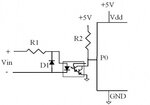maniac84
Full Member level 6
Hi guys, I want to build a circuit of production counter display where when there is an output from a machine, it Wil produce a count signal n my display Wil start increment one.
The machines are using PLC and different machine will produce different voltage of count signal. Some are 5vdc, 12vdc n 24vdc.
For my display, I use a pic controller which using 5vdc.
So, is there any component which can convert a large range of voltage, in my case 5vdc-24vdc to 5vdc where my pic controller can accept as input? Or is there other way to do this circuit?
The machines are using PLC and different machine will produce different voltage of count signal. Some are 5vdc, 12vdc n 24vdc.
For my display, I use a pic controller which using 5vdc.
So, is there any component which can convert a large range of voltage, in my case 5vdc-24vdc to 5vdc where my pic controller can accept as input? Or is there other way to do this circuit?
